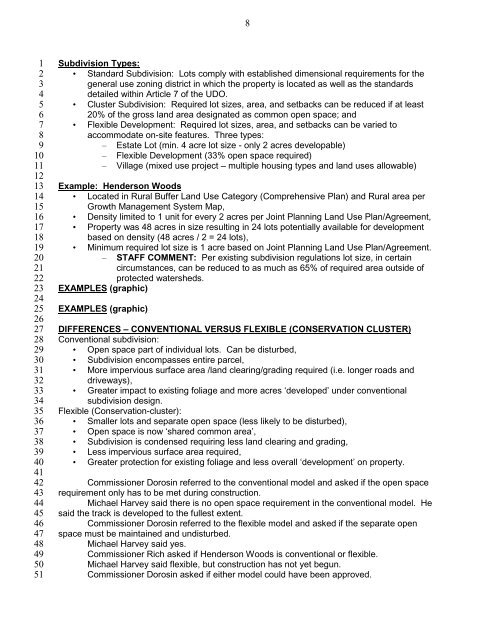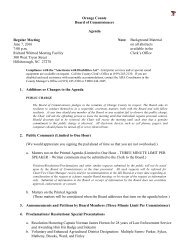1LwjabT
1LwjabT
1LwjabT
You also want an ePaper? Increase the reach of your titles
YUMPU automatically turns print PDFs into web optimized ePapers that Google loves.
8<br />
1<br />
2<br />
3<br />
4<br />
5<br />
6<br />
7<br />
8<br />
9<br />
10<br />
11<br />
12<br />
13<br />
14<br />
15<br />
16<br />
17<br />
18<br />
19<br />
20<br />
21<br />
22<br />
23<br />
24<br />
25<br />
26<br />
27<br />
28<br />
29<br />
30<br />
31<br />
32<br />
33<br />
34<br />
35<br />
36<br />
37<br />
38<br />
39<br />
40<br />
41<br />
42<br />
43<br />
44<br />
45<br />
46<br />
47<br />
48<br />
49<br />
50<br />
51<br />
Subdivision Types:<br />
• Standard Subdivision: Lots comply with established dimensional requirements for the<br />
general use zoning district in which the property is located as well as the standards<br />
detailed within Article 7 of the UDO.<br />
• Cluster Subdivision: Required lot sizes, area, and setbacks can be reduced if at least<br />
20% of the gross land area designated as common open space; and<br />
• Flexible Development: Required lot sizes, area, and setbacks can be varied to<br />
accommodate on-site features. Three types:<br />
– Estate Lot (min. 4 acre lot size - only 2 acres developable)<br />
– Flexible Development (33% open space required)<br />
– Village (mixed use project – multiple housing types and land uses allowable)<br />
Example: Henderson Woods<br />
• Located in Rural Buffer Land Use Category (Comprehensive Plan) and Rural area per<br />
Growth Management System Map,<br />
• Density limited to 1 unit for every 2 acres per Joint Planning Land Use Plan/Agreement,<br />
• Property was 48 acres in size resulting in 24 lots potentially available for development<br />
based on density (48 acres / 2 = 24 lots),<br />
• Minimum required lot size is 1 acre based on Joint Planning Land Use Plan/Agreement.<br />
– STAFF COMMENT: Per existing subdivision regulations lot size, in certain<br />
circumstances, can be reduced to as much as 65% of required area outside of<br />
protected watersheds.<br />
EXAMPLES (graphic)<br />
EXAMPLES (graphic)<br />
DIFFERENCES – CONVENTIONAL VERSUS FLEXIBLE (CONSERVATION CLUSTER)<br />
Conventional subdivision:<br />
• Open space part of individual lots. Can be disturbed,<br />
• Subdivision encompasses entire parcel,<br />
• More impervious surface area /land clearing/grading required (i.e. longer roads and<br />
driveways),<br />
• Greater impact to existing foliage and more acres ‘developed’ under conventional<br />
subdivision design.<br />
Flexible (Conservation-cluster):<br />
• Smaller lots and separate open space (less likely to be disturbed),<br />
• Open space is now ‘shared common area’,<br />
• Subdivision is condensed requiring less land clearing and grading,<br />
• Less impervious surface area required,<br />
• Greater protection for existing foliage and less overall ‘development’ on property.<br />
Commissioner Dorosin referred to the conventional model and asked if the open space<br />
requirement only has to be met during construction.<br />
Michael Harvey said there is no open space requirement in the conventional model. He<br />
said the track is developed to the fullest extent.<br />
Commissioner Dorosin referred to the flexible model and asked if the separate open<br />
space must be maintained and undisturbed.<br />
Michael Harvey said yes.<br />
Commissioner Rich asked if Henderson Woods is conventional or flexible.<br />
Michael Harvey said flexible, but construction has not yet begun.<br />
Commissioner Dorosin asked if either model could have been approved.



